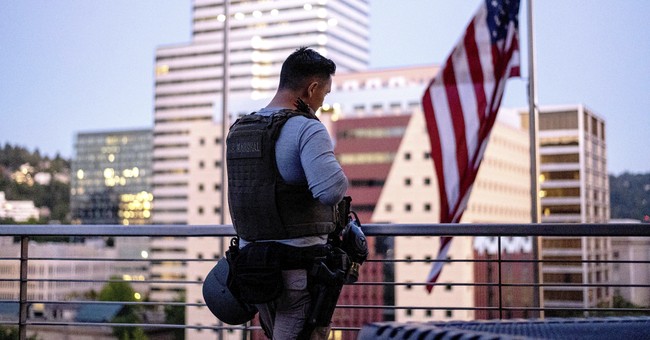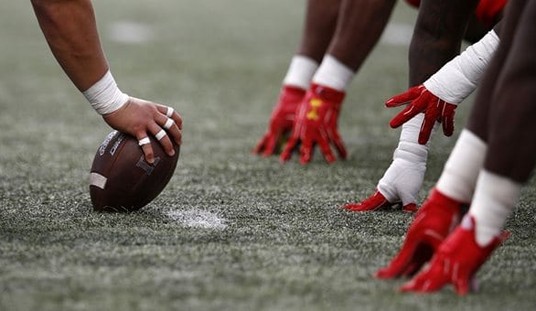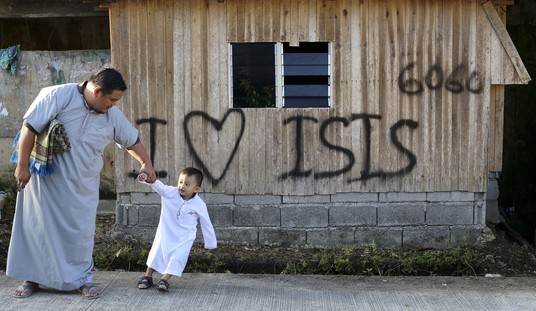
Rioters aren’t protesters and this story is proof. They’re out for blood and destruction, not peace or justice.
Reading the description of what Associated Press writer Mike Balsamo experienced during his night at the Mark O. Hatfield Federal Courthouse in Portland, Oregon is like reading something straight out of a war novel. Thousands of people descending on the building in order to bring it down as inside, federal agents brace for a long night of defending the building.
Balsamo described the scene around him, such as the defenses erected by police in order to help them repel the attackers. He paints a picture of a castle-like structure under siege:
The courthouse, a stately building with large windows and a white marble interior, looked like a feudal castle under siege. The outside was boarded up with thick plywood; narrow slits at the top of the plywood, accessed by a mechanized scaffolding, gave the agents inside a view of the crowd and an opening through which to fire pepper balls.
The terrace outside the front door was littered with garbage, the steps leading to the courthouse splattered with paint. A mixture of anti-police and Black Lives Matter graffiti covered the building’s outer walls and columns to a height of about 10 feet (3 meters).
Tear gas from the previous nights’ protests still hung in the air and coated the floor with a slime that had been hurriedly mopped up by custodians earlier that day. A few sickly looking potted plants still decorated the lobby, a reminder of a time before the courthouse was a battlefield.
Balsamo continues by describing the attitudes the rioters have toward the officers defending the courthouse. They don’t view them in any way that would grant them humanity as Balsamo says they see the officers as “at best thoughtless political minions, at worst murderous henchmen.”
What the officers are sure about the rioters are that if they gain access to the courthouse, these men will either be horribly injured or even killed by the attackers.
“It’s scary. You open those doors out, when the crowd is shaking the fence, and … on the other side of that fence are people that want to kill you because of the job we chose to do and what we represent,” said one Deputy U.S. Marshal.
“I can’t walk outside without being in fear for my life,” he added. “I am worried for my life, every time I walk outside of the building.”
The siege began at 10:15 after the rioters had danced together and celebrated in the streets. It began, at first, with a single rioter attempting to climb the fence. Soon after, the mass of humanity began leaning on the fence, making it bend sharply. Luckily, the fence held and the rioters regrouped for another round of dancing and chanting.
“We are not here being violent or being destructive. We have a positive message — there is nothing to quell here,” she said, in the midst of the destruction and violence. “The people of Portland are saying, ‘We don’t want this presence here and we don’t think we need them at all.’”
Balsamo then described the attack getting back underway:
As she spoke, small pods of three to four protesters dressed in black circulated in the crowd, stopping every few minutes to point green laser beams in the eyes of agents posted as lookouts on porticoes on the courthouse’s upper stories. The agents above were silhouetted against the dark sky as dozens of green laser dots and a large spotlight played on the courthouse walls, projected from the back of the crowd.
Thirty minutes later, someone fired a commercial-grade firework inside the fence. Next came a flare and then protesters began using an angle grinder to eat away at the fence. A barrage of items came whizzing into the courthouse: rocks, cans of beans, water bottles, potatoes and rubber bouncy balls that cause the agents to slip and fall.
Within minutes, the federal agents at the fence perimeter fired the first tear gas of the night.
Despite the secured position inside the courthouse, rioters still found ways to complicate things or hurt them:
Without lights, the agents hoped they would be better protected from people in the crowd who were firing metal ball bearings through the windows with sling shots. Thick ribbons of green light from blinding lasers crisscrossed the courthouse lobby, forcing the agents who were resting in between deployments to the fence to duck and weave to protect their eyes.
Agents on scaffolding fired pepper balls through the window slits at the crowd while others sat quietly on marble benches in the lobby, alone or in small groups, and waited for their turn at the fence.
No one talked much over the whir of the industrial fans set up to blow the tear gas back outside. The men who weren’t on the front line sat with helmets in their laps but left their gas masks on so they could breathe, the air still thick with chemical irritants.
Every few minutes, a huge boom from a commercial-grade firework tossed over the fence caused the walls to rattle; the crowd outside cheered as explosions of red, white and green flashed against a thick curtain of yellowish tear gas.
One agent being interviewed was hit with a professional-grade firework that burned his skin and deadened his hearing. With the help of his fellow agents, the stunned man was stripped to his boxers and t-shirt where his wounds could be examined and photographed for evidence. Five other federal agents would be injured by the end of the night, one of them suffering a concussion after being hit in the head by a firework.
It wasn’t until the wee hours of the morning that federal reinforcements came and pushed back the rioters with force. Tear gas and pepper balls were shot from federal lines that scattered rioters before them.
Before long, the sun had come out and agents emerged from the courthouse after, once again, they had successfully defended for another night. A deputy US Marshal made a comment on how normal the world is just outside of the courthouse area.
“I finally get outside at 7 a.m., after being in the building since 3 p.m. the day prior, and I look east and I’m like, ’Oh, the world’s normal over there and people are driving to work and the city is clean and functioning,” said the Deputy U.S. Marshal. “And I look out on the street and it looks like downtown Baghdad.”
The battle isn’t over, however. Despite the fact that agents can now go and get rested up, they have to be right back in the courthouse against that night and go through the siege all over again.
Despite this being a nightly occurrence, Democrats are calling the constant violence a “myth” as Jerry Nadler did in a recent interview.














Join the conversation as a VIP Member